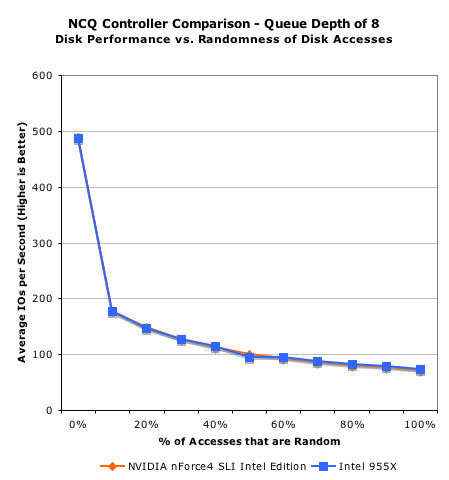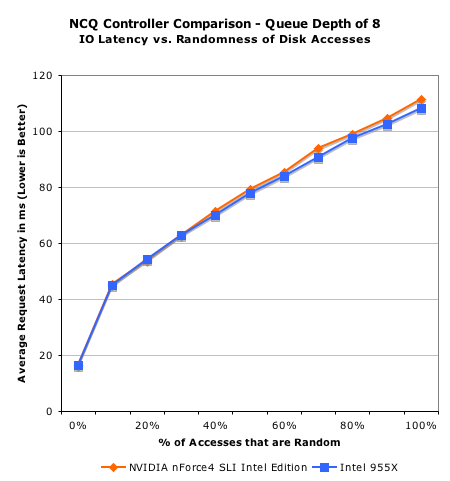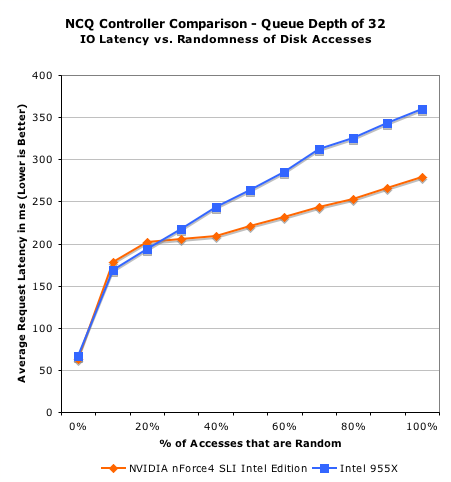Dual Core Intel Platform Shootout - NVIDIA nForce4 vs. Intel 955X
by Anand Lal Shimpi on April 14, 2005 1:01 PM EST- Posted in
- CPUs
SATA Controller Performance
Both NVIDIA and Intel offer support for NCQ in their SATA controllers, and given our recently renewed interest in NCQ performance, we decided to find out if there were any performance differences between the two SATA controllers. However, as we've found in the past, coming up with tests that stress NCQ is quite difficult. Luckily, there is a tool that works perfectly for controlling the type of disk accesses that you want to test: iometer.
An Intel developed tool, iometer allows you to control the size, randomness and frequency, among other things, of disk accesses, and measure performance using data generated according to these specifications. Given that NCQ truly optimizes performance when disk accesses are random in nature, we decided to look at how performance varied according to what percentage of the disk accesses were random. At the same time, we wanted the tests to be modeled on a multitasking desktop system, so we did some investigation by setting up a computer and running through some of our multitasking scenarios on it.
What we found is that on modern day hard drives, the number of outstanding IOs (IO Queue Depth) is rarely above 10 on even a moderately taxed system. Only when you approach extremely heavy multitasking loads (heavier than anything that we've ever tested) do you break into queue depths beyond 32. So, we put together two scenarios, one with a queue depth of 8 and one with a queue depth of 32 - the latter being more of an extreme condition.
In each scenario, we sent the drives a series of 64KB requests, 75% of which were reads, 25% were writes; once again, derived from monitoring our own desktop usage patterns.
We then varied the randomness of disk accesses from 0% (e.g. 100% sequential) up to 100% (0% sequential reads/writes). In theory, the stronger NCQ controllers will show better performance as the percentage of random accesses increases. We reported both Average IOs per Second and average IO response time (how long accesses took to complete on average):

With a queue depth of 8, the two SATA controllers offer virtually identical performance.

Looking at latency, Intel actually offers a very slight performance advantage here - nothing huge, but it's definitely there.
The results get much more interesting as we increase the queue depth to 32:

Here, NVIDIA starts to pull away offering close to a 20% increase in average IOs per second as the access patterns get more random (e.g. as more applications running at the same time start loading down the hard disk).

What's truly impressive, however, is the reduction in average response time - up to a 90ms decrease in response time, thanks to NVIDIA's superior NCQ implementation.
But stepping back into reality, how big of a difference NVIDIA's NCQ implementation makes depends greatly on your usage patterns. Heavy multitaskers that are very IO bound will notice a performance difference, while more casual multitaskers would be hard pressed to find any difference. For example, Intel was actually faster than NVIDIA in our gaming multitasking scenarios from our dual core investigation.










96 Comments
View All Comments
mlittl3 - Friday, April 15, 2005 - link
Sorry one typo in that last post.I should have said, "...AMD's processors f**king rock."
:)
mlittl3 - Friday, April 15, 2005 - link
Oh and one other thing. Because Intel has such an influence on the IT industry, their constant indecision has cost us many delays in technology.Only until Intel moved to 64 bits in the last 12 months has Microsoft surprisingly come out with WinXP 64. The industry won't move unless Intel moves. And when they move everyone has to jump.
Programmers are now scrambling to optimize code for 64bits and multithreading because they can't get their 5 GHz singlethreaded 32bit Prescott anymore. AMD said it was going that way and that the rest of the IT industry needs to go to 64bits and dual cores. They said this almost two years ago when they released the K8 architecture.
No one jumped. No one changed their code. We are slaves to Intel's whims because no one will make a decision unless Intel tells them too. Innovation will always suffer at the likes of monopolies like Intel. Thankfully, AMD's processors were so superior to Intel's that the chip giant had to budge or face market share decreases.
If you think I'm a conspiracy theory crackpot, I let current events speak for themselves. Why does a 80%+ market share, $80 bill revenue per year, industry leader have to adopt any tactics from a small insignificant rival like AMD?
I tell you the answer, AMD's processors rock.
Thank you. That is all.
mlittl3 - Friday, April 15, 2005 - link
#59, #63I am not done flaming questar after his last post about roadmaps (#54).
That is the biggest Intel loving bunch of bullsh*t I have ever heard.
To keep the record straight, Intel completely tore up its roadmaps last year when it cancelled plans for its 4GHz prescott. They completely changed their entire marketing and engineering strategy. Their entire roadmap is different now.
I get so mad when people like him just see Intel's name and assumes stable roadmaps. I've been following tech for many years now, so here we go.
Fact #1. Intel promoted Megahertz=performance for years.
Fact #2. Intel recently said that megahertz isn't everything and other factors need to be considered.
180 reversal.
Fact #3. Intel said they would never use model numbers to identify processors and that AMD was misleading their customers.
Fact #4. Intel now uses model numbers to identify their processors.
180 reversal.
Fact #5. Intel was going to use the netburst architecture up to 6 GHz+.
Fact #6. Intel has cancelled any concrete plans to increase processor speed beyond 4 GHz in the immediate future.
180 reversal.
Fact #7. Intel was going to use the Pentium 4 for all laptops.
Fact #8. As I currently write this, no current Dell laptop models (Intel's largest distributor) have a pentium 4 in them.
180 reversal
Fact #9. Intel said a year ago that 64bits is not ready for many years and will not implement the technology until it is ready.
Fact #10. All currently released Intel processors except for 5xx and Pentium M use EM64T technology.
180 reversal.
Fact #11. There were no plans for dual core in Intel processors until AMD said that dual core was planned from the beginning of the K8 architecture.
Fact #12. Intels "fastests" processors are becoming dual core.
180 reversal.
Questar, exactly what 3 year roadmaps from Intel have remained unchanged? We have no idea if Intel will change on us again and go a completely different route. How do you know that the current 3 year roadmap will stay unchanged? Do you have a crystal ball? No one can foresee that far into the future in the IT industry.
3 years ago Intel showed roadmaps of the Pentium 4 to go to 6 GHz with no model numbers, no 64bits, no Pentium M, no dual core. I really need some clarification from you because I'm so confused.
And all you other loyal IT readers out there, please let me know if I left any other 180 reversal of Intel out. There have been so many it's hard to keep track.
Calin - Friday, April 15, 2005 - link
Motley, I totally agree PCI Express is good for alot of things - SCSI, iSCSI, Gigabit Ethernet, and others. However, you won't see neither one of them on the mainboards with 915, 925x or similar chipsets. Those kind of things appear on server-level chipsets, and some of them had PCI-E for quite some timeCalin - Friday, April 15, 2005 - link
"It's pretty clear - Intel's last few products have been worthless in many cases."You damn americans - just because something is not the absolute number one, it means it is worthless?
I would like to have a Northwood processor at 3.6 GHz and at the price of a Sempron 2200, but that doesnt' mean Prescott are worthless
Dennis Travis - Friday, April 15, 2005 - link
Anand, You were right to keep this test Intel since that is what the test was about anyway, Dual Core Intel on either NVIDIA or Intel boards. When the Dual Core AMD's come out, then it would be great to see a test with both platforms on the NVIDIA NF4 boards.mkruer - Friday, April 15, 2005 - link
Anand; I hope that when you get the Athlon64 X2, if you don’t have it already, you will end up doing the most comprehensive benchmarking on the planet! The full Server/Desktop/Multimedia/Games package. Testing Single Xeon, Single Opteron, Dual Xeon, Dual Opteron, Dual-Core P4 and Dual-Core Opteron. Also I would recommend against using benchmarking suites, instead use real world applications. In fact, that would be an interesting tests in it self. Does benchmarking suites really give accurate results compared to the real product?thelostjs - Friday, April 15, 2005 - link
umm overclocking comparo? <-- humble broke teenchennhui - Friday, April 15, 2005 - link
#63Pro & Con of Hyperthreading
http://www.anandtech.com/showdoc.aspx?i=1746&p...
KeithDust2000 - Friday, April 15, 2005 - link
JoKeRr, "And if we look ahead, Intel is making dualcore 65nm's thermal evenlope same as Northwood at 89W (don't count on me though), I'm impressed b/c Intel is actively addressing the problems."They were responsible for the problems in the first place, and the only reason they are addressing them is that they now have some competition that would gain a lot of market share if they continued to ignore the interests of their customers going forward. If there´s something admirable about that, I must have missed it.